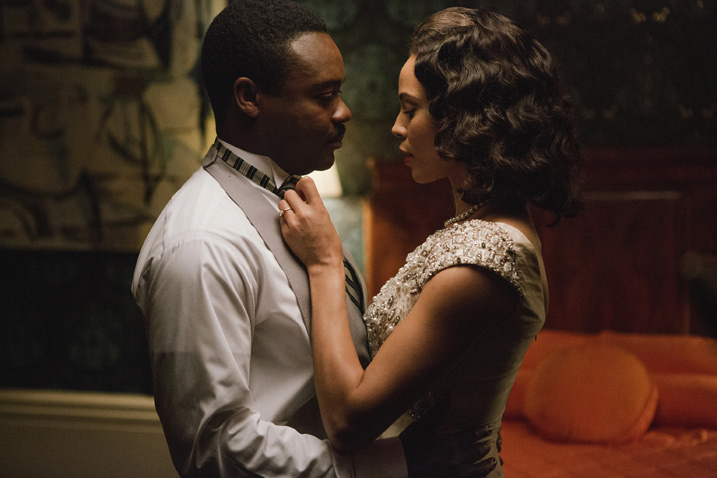 “Selma” is vital correspondence, filmmaking lived on the streets where brutal facts were ignored then reported, and now snatched back from history to sustain a spirit few films can or will possess. It is stunning humanistic cinema on a mainstream scale, made by a group of unconventional artists. Premiered in an unfinished cut at AFI Fest, this rarely feels like any biopic you’ve seen. It has inventiveness, urgency, humor, and most of all emotion that draws effortless parallels rather than leaving its lesson up on the screen.
“Selma” is vital correspondence, filmmaking lived on the streets where brutal facts were ignored then reported, and now snatched back from history to sustain a spirit few films can or will possess. It is stunning humanistic cinema on a mainstream scale, made by a group of unconventional artists. Premiered in an unfinished cut at AFI Fest, this rarely feels like any biopic you’ve seen. It has inventiveness, urgency, humor, and most of all emotion that draws effortless parallels rather than leaving its lesson up on the screen.
Even the title cards offer something fresh. Clacking up in Courier New alongside an FBI stamp, they frame three months of Martin Luther King Jr.’s life in 1965 as he tried to secure the Voting Rights Act as the monitored event it was. With Lyndon Johnson (Tom Wilkinson) dragging his feet on policy change and Alabama governor George Wallace (a gleefully sinister Tim Roth) preventing all efforts within Selma to organize, King journeys down to the town to plan a trio of nonviolent marches—events which opened the nation’s eyes to the situation down South.

The title is precise. Director Ava DuVernay’s third film chronicles the changing tides in Selma and examine how actions lend power to a word to it passes into charged shorthand. However, in that case the name David Oyelowo will shift with context but likely stay honest. Last seen in this year’s indie “Nightingale” and next in “A Most Violent Year,” Oyelowo captures King from frame one, shading the man’s signature characteristics with the quiet but motivated manner mostly heard in third-person accounts.
One of them is with Coretta King (Carmen Ejogo), with whom DuVernay spends time at home to dissect the tense dynamic between Martin and herself. Hounded by death threats and reports of Martin’s infidelity, she negotiates in a series of interactions her husband’s true feelings. These passages could easily have strayed into unduly generated melodrama in the wrong hands, but DuVernay—new to a studio budget, but fluent in black relationships (“I Will Follow”, “Middle of Nowhere”)—shines here with nuance.

Of course King’s iconic speeches also factor into the film’s narrative, as threats and obstacles shift his supporters toward confusion and retaliatory anger. To their credit, Oyelowo and DuVernay stage each one brilliantly, charting a charged emotional arc in Oyelowo’s performance while also showcasing the film’s other standout element, evident to anyone who’s seen a frame of the film.
Cinematographer Bradford Young, lending his stamp to DuVernay’s previous films, as well as “Ain’t Them Bodies Saints” and “Restless City,” lights the film in sun-baked tableaus, evoking Roy DeCarava and Leonard Freed’s photographic work, and shaping light sources around darkness and deep reds that are simply sublime.
Coupled with unconventional additions of their own—a wide-angle lens viewing a crowd, or asymmetrical framing of characters and details—Young and DuVernay elevate one another in nearly every scene. Their greatest feat comes in the form of the March on Montgomery itself, or rather the protestors’ first confrontation with state police across the Edmund Pettus Bridge. Though reliant on some televisual moments, DuVernay and young craft a powerful montage of violence and hatred—vicious when it needs to be, but never exploitative or unearned.

The supporting cast also blend wonderfully into their real-life counterparts, with writers DuVernay and Paul Webb finding worthy slices of drama in their script for people like Annie Cooper (Oprah Winfrey), Amelia Boynton (Lorraine Toussaint), Cager Lee (Henry G. Sanders), and Jimmie Lee Jackson (Keith Stanfield). As for the tone, it takes on the mood of a terse political thriller, each faction, major (the White House) and minor (the SNCC), talking through strategy and figuring out the opposition’s weaknesses.
DuVernay has said the prospect of tackling King’s life never crossed her mind, a focus on modern relationships more appealing as subject matter and style. But the match turned out to be essential.
Sidestepping clichés of the genre for more approximate truths of the period, the director has conjured a vibrant, subtle yet strong document—of the ‘60s, yes, but her camera lingers on faces and ideas, not period clothes and stylistic flourishes. It is now, and every other decade, in which injustices were practiced, and hopefully this film will be continually shown to remind us of that fact. [A]

